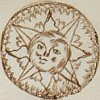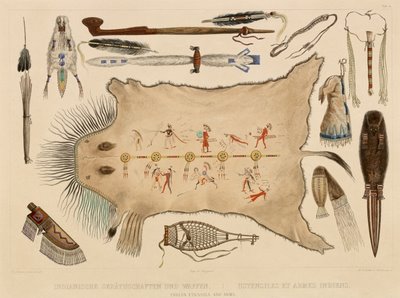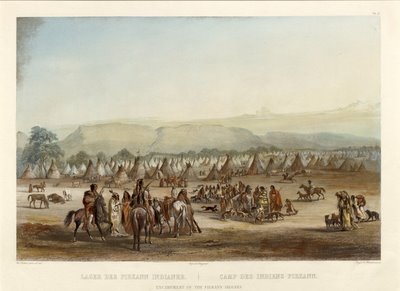








'The Natural History of the Rarer Lepidopterous Insects of Georgia' is a 2 volume set published in 1797. It was the first illustrated work on American insects and both books are online at the Missouri Botanical Gardens website.
The notional author is the founder and first President of the Linnean Society, Sir James Edward Smith. But the 104 illustrations between the 2 books and much of the text actually derives from the watercolours and notes of John Abbott (see previous post with the original illustrations). Abbott moved to America from England when he was 22 years old and devoted the rest of his life to studying and painting the insects and birds of Georgia.
Friday, August 11, 2006
Georgia Insects
Wednesday, August 09, 2006
Codex Canadiensis
"The Codex canadiensis is a 79-page document written circa 1700. Illustrated with 180 drawings, it describes the First Nations, plants, mammals, birds and fish of Canada."
 The background to this manuscript is a little mysterious - nothing at all is known of its history prior to 1930 when a facsimile edition was published in France. Around this time the oil magnate Thomas Gilcrease purchased the original work and eventually donated it to the Gilcrease Museum in Tulsa, Oklahoma where it still remains.
The background to this manuscript is a little mysterious - nothing at all is known of its history prior to 1930 when a facsimile edition was published in France. Around this time the oil magnate Thomas Gilcrease purchased the original work and eventually donated it to the Gilcrease Museum in Tulsa, Oklahoma where it still remains. There has been a lot of speculation over the authorship of the manuscript with the current position being that it comes from Louis Nicolas, a somewhat renegade Jesuit priest, who spent 11 years in Canada as a missionary and languages expert, from 1664. However, it is not his hand that actually produced the Codex - he died in 1682 - it is said to have been written/drawn by a colleague who knew his work well.
There has been a lot of speculation over the authorship of the manuscript with the current position being that it comes from Louis Nicolas, a somewhat renegade Jesuit priest, who spent 11 years in Canada as a missionary and languages expert, from 1664. However, it is not his hand that actually produced the Codex - he died in 1682 - it is said to have been written/drawn by a colleague who knew his work well.Library and Archives Canada, in partnership with the Gilcrease Museum and the Gail and Stephen A. Jarislowsky Institute for Studies in Canadian Art have launched a brand new website devoted to Codex canadiensis. There is ample commentary and both an html and a flash turn-the-pages presentation.
[via David Mattison's The Ten Thousand Year Blog - a site devoted to digital preservation, particularly as it pertains to Canada]
{I've touched up the background in some of the above images. Most are details. Click the map and the last 2 images for much larger versions - which come from the 'What is Codex canadiensis?' section of the site}
Monday, August 07, 2006
A Rose By Any Other Name..
"Your Honour, I concede that at first glance it appears I have breached copyright by publishing certain illuminated manuscript images on the website called BibliOdyssey. I agree that copying or publishing even a single pixel of data requires specific permission from each of the four institutions which maintain the research portal where the digitized manuscript images are hosted.
But the court should hear that after obsequiously petitioning the portal adminstrator and receiving an access password, I was immediately overwhelmed by the beauty and artisanship on display, such that close reading of the terms and conditions did not suggest itself as a matter for priority.
Instead, I set about studying the images and every so often I took screen captures of small segments from random pages which were downloaded to my local hard drive. All the images published on BibliOdyssey required splicing together of up to seven individual screen captures to meet the stringent BibliOdyssey sizing policies. These activities took place some months before the alleged copyright breach.
So it was Your Honour that I recently chanced upon the images in question after overlooking them for some time, but try as I might, I could not recall the name of the famous set of manuscripts nor the website address of the portal. After deliberating long and hard I made the decision to publish them anyway, deciding that the passage of 600 years ought to have substantially extinguished the plaintiff's copyright assertions.
Normal practice at BibliOdyssey is to be assiduous in providing attribution and identifying owners and/or copyright holders in relation to published images. The abberrant conduct at issue today should therefore be viewed as a single uncharacteristic episode in which an exceedingly small amount of manuscript material was displayed so that some other people might have the opportunity to enjoy the medieval beauty that is usually hidden away in padlocked digital cloisters.
I submit that the extenuating circumstances outlined are sufficient justification for publishing the images and I ask that Your Honour dismiss the plaintiff's suit. Thank you."
The Wood Book






[click for much larger versions - worth viewing for the detail]
Martinus Houttuyn (1720-1798) was trained in medicine but established his own printing firm in his native Holland to publish natural history books.
In 1773 the first 6 plates of 'Houtkunde'* ['A representation of inland and foreign wood'] were released as an unbound book with hand coloured prints.
Houttuyn combined with the printer JC Sepp and ultimately 106 illustration plates were made and released in book form accompanied by their species and common names in english, dutch, german, french and latin.
In the beginning Houttuyn intended that his 'Houtkunde' should be favoured by keepers of 'wunderkammer', but the title page from a later edition envisioned a wider audience - “‘Houtkunde’ represents inland and foreign wood, used to build houses and ships, as well as for cabinets, tools, paints and also for medicine”. (Houttuyn had included an index in dutch with notes on the origin, use and properties of the specimens depicted)
*'Houtkunde' translates online as 'knowledge' but if any Dutch visitors can confirm it, I'm presuming it also means something like 'forest' or 'woods' - it turned up frequently searching.
"‘Houtkunde’ gives us an impression of the wood collections in cabinets of natural curiosities which, in many cases, have been lost. It is also an important source of information about the knowledge and use of wood in the 18th century. Furthermore, the book helps to decipher the different names often given to a specific type of wood."
- 'Houtkunde' is online in its entirety (including early and late edition changes) at the TU Delft Library in Holland [LINK UPDATED OCT. 2013]. But be warned: all the pages of text are merely photocopies and the plates are enormous (~4Mb each) png files.
- Perhaps a 'modern' equivalent to this 'woodopedia' is the 14 volume series by Romeyn Beck Hough: 'The American Woods', published between 1888 and 1910. It consists of actual crosscuts of 350 tree specimens. The whole series has been digitized by North Carolina State University. The rest of that incredibly fastidious parent History of Forestry website is worthy of a browse; there must be a kitchen sink in there somewhere. [Thanks Tom ('Marxchivist')]
Sunday, August 06, 2006
The Bodmer Series on Native America
Karl Bodmer (1809-1893) was a Swiss artist hired by the German naturalist Prince Maximilian zu Wied-Neuwied to travel with him on an expedition across the American west and up the Missouri river.
Prince Maximilian wanted "to bring along a draftsman who [..] must be a landscape painter but also be able to depict figures correctly and accurately, especially the Indians."
It seems the Prince was satisfied from the outset: "He is a lively, very good man and companion, seems well educated and is very pleasant and suitable for me; I am glad I picked him. He makes no demands and in diligence, he is never lacking."
And even moreso with hindsight: "If I could only show you, my dear [brother] August, Mr. Bodmer's portfolio. How many times you would exclaim: 'Oh, excellent! Beautiful! Beautiful!' "
Their travels took place between 1832 and 1834 and over the following years Bodmer personally directed the creation of about 80 aquatint plates that would accompany the Prince's commentary. 'Travels in the Interior of North America' was published in Europe in various formats between 1839 and 1843.
It was not until after WWII that the complete body of work produced by Bodmer during the American journey was discovered. Hundreds of sketches and watercolour paintings were purchased from Prince Maximilian's descendents and the majority are now housed at the Joslyn Gallery in Nebraska.
"The significance of Bodmer's illustrations cannot be overemphasized. Few explorers had ever engaged professional artists to document their journeys. Maximilian insisted that the European-trained Bodmer paint with strict attention to detail. The resulting watercolors, upon which the published aquatints were based, had a photographic accuracy that was unequaled and which have subsequently proved invaluable to historians and ethnologists. For over one-hundred-fifty years Bodmer's aquatints have remained the major source of information regarding Plains Indian culture."
- The images above come from a University of Utah collection of both black and white and colour prints from 'Travels in the Interior of North America'.
- An original sketchbook (I actually posted an image from here previously) by Bodmer is on display at the excellent French Drawings website (Bodmer eventually became a French citizen, concentrating on book illustration in later life).
- The Maximilian-Bodmer Expedition at Joslyn Art Museum.
- 'Karl Bodmer's Visionary Years' - an essay by Mary Terrence McKay.
- 'Karl Bodmer's North American Prints' Edited by Brandon K. Ruud and published in 2005 is by all accounts the definitive compilation and analysis of Bodmer's American artistic legacy (2 inches thick and weighing 5 pounds, it includes 431 illustrations).











































































